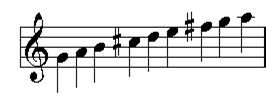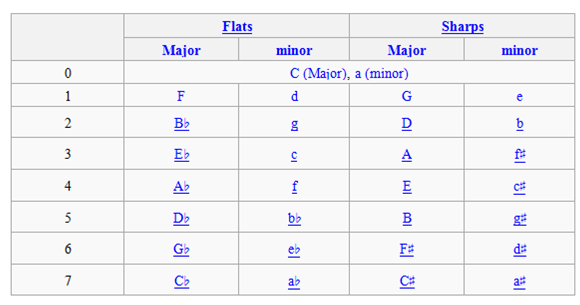| This Week’s Topic… | |

Best viewed in
|
Key Signatures and Key In musical notation, a key signature is a series of sharp symbols (#) or flat symbols (b) placed on the staff, designating notes that are to be consistently played one semitone higher or lower than the equivalent natural notes (for example, the white notes on a piano keyboard) unless otherwise altered with an accidental. Key signatures are generally written immediately after the clef at the beginning of a line of musical notation, although they can appear in other parts of a score, notably after a double bar. The purpose of the key signature is to minimize the number of accidentals required to notate the music. In principle, any piece can be written with any key signature, using accidentals to correct any notes where it shouldn't apply. For example, here is the bagpipe scale using the appropriate symbols:
Instead of placing a sharp (#) in front of every “C” and “F”, the key signature tells the musician that throughout the music there will be 2 sharps; “C” and “F”. Here is the same scale written with the key signature:
A key signature is not the same as a key; a key signature is merely a notational device. The key identifies the tonic triad, the chord, major or minor, which represents the final point of rest for a piece, or the focal point of a section. A key may be major or minor. Although many musicians confuse key with scale, a scale is an ordered set of notes typically used in a key, while the key is the center of gravity, established by particular chord progressions. For key signatures with sharps, the first sharp is placed on F line. Subsequent additional sharps are added on C, G, D, A, E and B. In the illustration below, you can see that bagpipe music, written with two sharps, is in the key of B minor or D major. In Germany, Scandinavia, Serbia, Croatia and Poland it is referred to as "h-moll".
In baroque times, B minor was regarded as the key of passive suffering. The theorist Christian Daniel Schubart regarded B minor as a key expressing a quiet acceptance of fate and very gentle complaint, something commentators find to be in line with Bach's use of the key in the St. John's Passion. By Beethoven's time, however, the perception of B minor had changed considerably: Francesco Galeazzi wrote that B minor was not suitable for music in good taste, and Beethoven labeled a B minor melodic idea in one of his sketchbooks as a "black key". |


